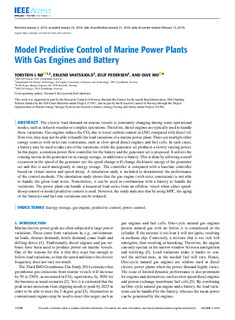| dc.contributor.author | Bø, Torstein Ingebrigtsen | |
| dc.contributor.author | Vaktskjold, Erlend | |
| dc.contributor.author | Pedersen, Eilif | |
| dc.contributor.author | Mo, Olve | |
| dc.date.accessioned | 2019-05-08T07:10:54Z | |
| dc.date.available | 2019-05-08T07:10:54Z | |
| dc.date.created | 2019-02-01T08:41:25Z | |
| dc.date.issued | 2019 | |
| dc.identifier.issn | 2169-3536 | |
| dc.identifier.uri | http://hdl.handle.net/11250/2596893 | |
| dc.description.abstract | The electric load demand on marine vessels is constantly changing during some operational modes, such as in harsh weather or complex operations. Therefore, diesel engines are typically used to handle these variations. Gas engines reduce the CO2 due to lower carbon content in LNG compared with diesel oil. However, they may not be able to handle the load variations of a marine power plant. There are multiple other energy sources with strict rate constraints, such as slow speed diesel engines and fuel cells. In such cases, a battery may be used to take care of the variations, while the generator set produces a slowly varying power. In this paper, a common power flow controller for the battery and the generator set is proposed. It utilizes the rotating inertia in the generator set as energy storage, in addition to a battery. This is done by allowing a small excursion in the speed of the generator set; the speed change will change the kinetic energy of the generator set and this is used analogously to energy storage. The controller is compared with a baseline controller based on virtual inertia and speed droop. A simulation study is included to demonstrate the performance of the control methods. The simulation study shows that the gas engine (with strict constraints) is not able to handle the given load series. Nonetheless, it can be used in combination with a battery to handle the variations. The power plant can handle a measured load series from an offshore vessel when either speed-droop control or model predictive control is used. However, the study indicates that by using MPC, the aging of the batteries and fuel rate variations can be reduced. | nb_NO |
| dc.language.iso | eng | nb_NO |
| dc.publisher | Institute of Electrical and Electronics Engineers (IEEE) | nb_NO |
| dc.relation.uri | https://ieeexplore.ieee.org/document/8630598 | |
| dc.rights | Navngivelse 4.0 Internasjonal | * |
| dc.rights.uri | http://creativecommons.org/licenses/by/4.0/deed.no | * |
| dc.title | Model Predictive Control of Marine Power Plants with Gas Engines and Battery | nb_NO |
| dc.type | Journal article | nb_NO |
| dc.type | Peer reviewed | nb_NO |
| dc.description.version | publishedVersion | nb_NO |
| dc.source.journal | IEEE Access | nb_NO |
| dc.identifier.doi | 10.1109/ACCESS.2019.2895163 | |
| dc.identifier.cristin | 1671832 | |
| dc.relation.project | Norges forskningsråd: 237917 | nb_NO |
| dc.relation.project | Norges forskningsråd: 254766 | nb_NO |
| dc.description.localcode | This work is licensed under a Creative Commons Attribution 3.0 License. For more information, see http://creativecommons.org/licenses/by/3.0/ | nb_NO |
| cristin.unitcode | 194,64,20,0 | |
| cristin.unitname | Institutt for marin teknikk | |
| cristin.ispublished | true | |
| cristin.fulltext | preprint | |
| cristin.qualitycode | 1 | |

